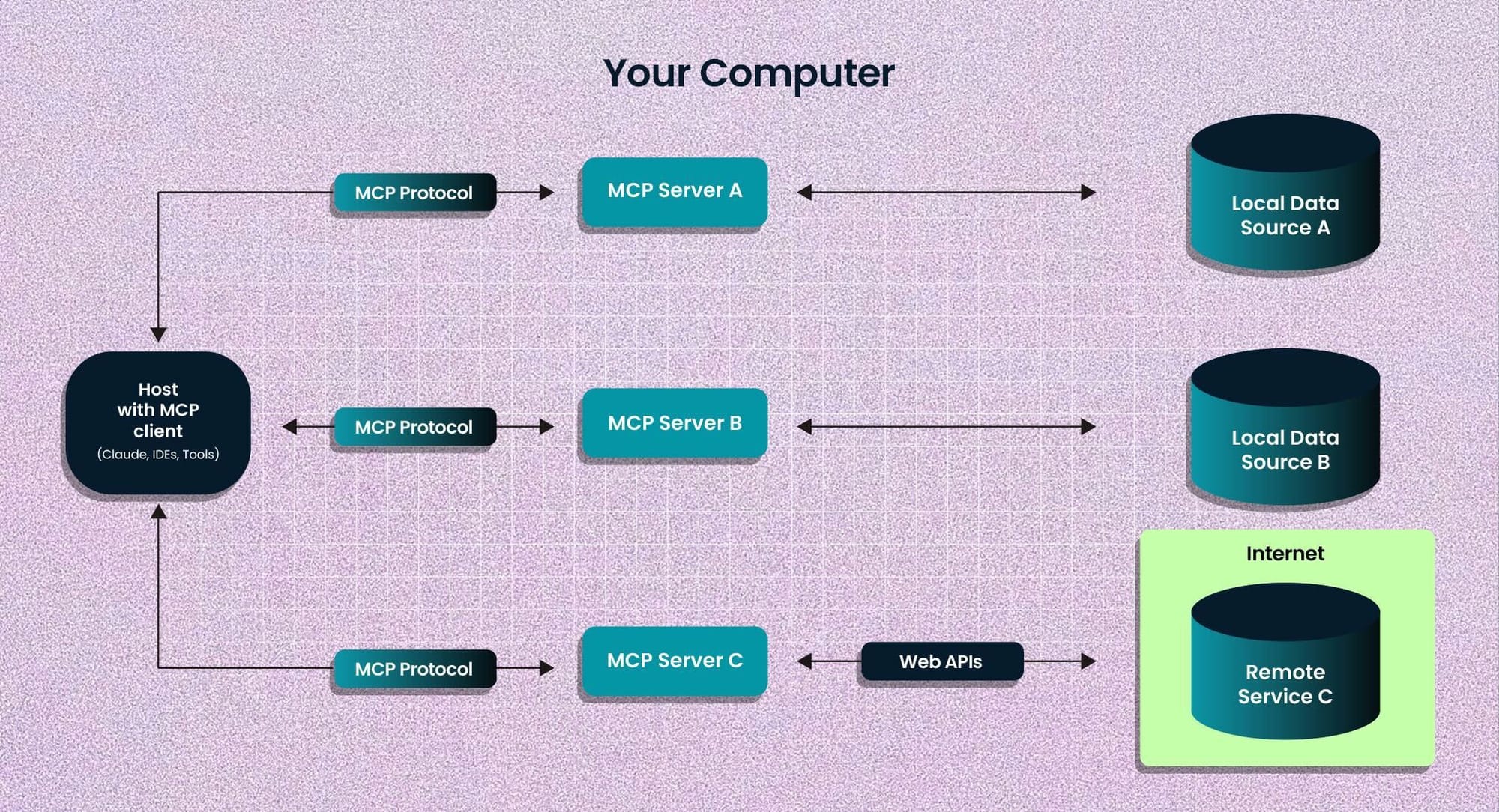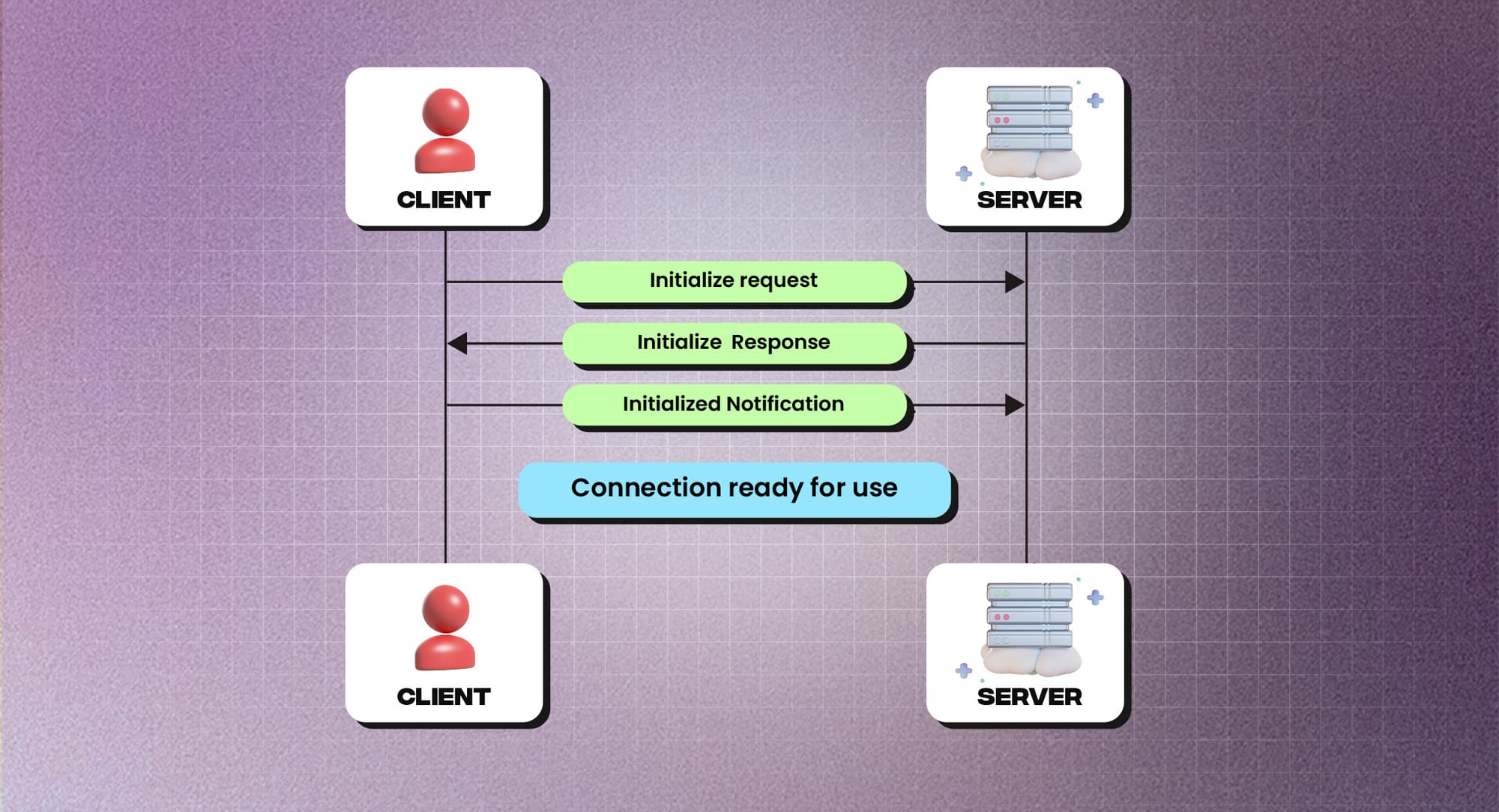Integrating AI models with external data sources has traditionally been a complex and fragmented process, often requiring custom code for each dataset. This approach not only consumes significant development time but also poses challenges in maintaining and scaling integrations.
To address these issues, Anthropic introduced the Model Context Protocol (MCP), an open-source tool designed to standardize and simplify the connection between AI assistants and various data sources.
What is MCP (Model Context Protocol) ?
MCP serves as a universal interface that allows AI tools to interact seamlessly with content repositories, business platforms, and development environments. By providing a standardized framework, MCP enhances the relevance and context-awareness of AI applications.
This universal protocol aims to simplify integration across different AI systems and data, addressing the current need for custom coding for each dataset.
General Architecture of MCP
At its core, MCP follows a client-server architecture where a host application can connect to multiple servers:
- Hosts: These are LLM applications (like Claude Desktop or Integrated Development Environments) that initiate connections. The host process acts as the container and coordinator, managing multiple client instances, controlling client connection permissions and lifecycle, enforcing security policies, handling user authorization decisions, coordinating AI/LLM integration and sampling, and managing context aggregation across clients.
- Clients: Each client is created by the host and maintains an isolated server connection. Clients establish one stateful session per server, handle protocol negotiation and capability exchange, route protocol messages bidirectionally, manage subscriptions and notifications, and maintain security boundaries between servers.
- Servers: Servers provide specialized context and capabilities. They expose resources, tools, and prompts via MCP primitives, operate independently with focused responsibilities, and request sampling through client interfaces.
- Local Data Sources: Your computer’s files, databases, and services that MCP servers can securely access
- Remote Services: External systems available over the internet (e.g., through APIs) that MCP servers can connect to

Core Components of MCP (Model Context Protocol)
- Protocol Layer: The protocol layer handles message framing, request/response linking, and high-level communication patterns. Key classes include
- Protocol
- Client
- Server
- Transport Layer: The transport layer handles the actual communication between clients and servers. All transports use JSON-RPC 2.0 to exchange messages. MCP supports multiple transport mechanisms:
- Stdio transport
- HTTP with SSE transport
Message Types of MCP
MCP has these main types of messages:
- Requests expect a response from the other side
- Results are successful responses to requests
- Errors indicate that a request failed
- Notifications are one-way messages that don’t expect a response

Resources in Model Context Protocol
Resources are a core primitive in the Model Context Protocol (MCP) that allow servers to expose data and content that can be read by clients and used as context for LLM interactions.
- File contents
- Database records
- API responses
- Live system data
- Screenshots and images
- Log files
- And more
Partner with Us for Success
Experience seamless collaboration and exceptional results.
Each resource is identified by a unique URI and can contain either text or binary data.
Benefits of Using the Model Context Protocol (MCP)
Adopting the Model Context Protocol (MCP) offers a multitude of advantages that streamline development processes, enhance system architecture, and bolster security measures.
1. Simplified Integration Processes
- Standardized Connectivity: MCP provides a universal protocol for connecting AI systems with diverse data sources, eliminating the need for custom integrations for each dataset. This standardization reduces development time and complexity.
- Unified Development Approach: Developers can implement MCP once and seamlessly connect to multiple data sources, streamlining the integration process and reducing redundancy.
2. Enhanced Composability and Modularity
- Component-Based Architecture: MCP's design promotes a modular approach, allowing developers to build applications with interchangeable components. This enhances flexibility and scalability in system design.
- Interoperability: By adhering to open standards, MCP ensures that various AI applications and tools can work together seamlessly, fostering a cohesive ecosystem.
3. Improved Security and Data Isolation
- Granular Access Controls: MCP incorporates detailed access control mechanisms, allowing for precise management of permissions and enhancing data security.
- Data Segmentation: The protocol's architecture supports data isolation, ensuring that sensitive information is compartmentalized and protected from unauthorized access.
4. Accelerated Development and Maintenance
- Reduced Redundancy: With MCP's standardized approach, developers no longer need to create custom connectors for each data source, significantly reducing repetitive coding tasks.
- Easier Maintenance: A unified protocol simplifies the maintenance process, as updates or changes can be applied universally rather than individually to each integration.
5. Future-Proofing and Scalability
- Adaptability: MCP's flexible framework allows for easy adaptation to emerging technologies and data sources, ensuring long-term viability.
- Scalable Integrations: The protocol supports scalable architectures, enabling systems to grow and integrate additional functionalities without significant overhauls.
6. Enhanced Performance and Efficiency
- Direct Data Access: By facilitating direct connections between AI models and data sources, MCP reduces latency and improves response times, leading to more efficient operations.
- Optimized Resource Utilization: Standardized integrations allow for better resource management, optimizing system performance and reducing overhead.
Partner with Us for Success
Experience seamless collaboration and exceptional results.
Real-World Applications and Adoption of MCP
The Model Context Protocol (MCP) has rapidly gained traction across various industries, demonstrating its versatility and effectiveness in enhancing AI capabilities. Below is an exploration of its real-world applications and the extent of its adoption:
1. Industry Adoption
- Major Tech Companies: Several prominent technology firms have integrated MCP into their platforms, showcasing its practical benefits. This widespread adoption underscores MCP's reliability and effectiveness in real-world scenarios.
- Coding Platforms: Platforms such as Replit, Codeium, and Sourcegraph have adopted MCP to enhance their AI agents, enabling these tools to perform tasks on behalf of users with greater efficiency and accuracy.
- Enterprise Integration: Companies like Goldman Sachs and AT&T have utilized AI models compatible with protocols like MCP to streamline various business functions, including customer service and code generation.
2. Community Engagement
- Open-Source Contributions: The open-source nature of MCP has fostered a vibrant developer community, leading to continuous enhancements and a growing repository of tools and integrations. This collaborative environment accelerates innovation and broadens MCP's applicability.
- Educational Resources: The community has generated extensive documentation, tutorials, and best practices, facilitating easier adoption and implementation of MCP across various projects.
3. Diverse Applications
- AI Assistants: MCP enables AI assistants to access and interact with external data sources seamlessly, improving their ability to provide accurate and contextually relevant responses.
- Development Tools: Integrated Development Environments (IDEs) and other development tools leverage MCP to offer AI-driven code suggestions, debugging assistance, and project management features, enhancing developer productivity.
Conclusion
The Model Context Protocol (MCP) represents a pivotal advancement in the integration of AI models with external data sources and tools. By establishing a standardized, secure, and efficient framework, MCP addresses the complexities and inefficiencies associated with fragmented data access and custom integrations. Its adoption facilitates seamless connectivity, enhancing the relevance and accuracy of AI applications across various domains.
Looking ahead, MCP's evolution is set to drive significant transformations in AI development:
- Sustainable AI Architectures: As MCP matures, it will enable AI systems to maintain context across diverse tools and datasets, fostering more sustainable and scalable AI architectures.
- Widespread Adoption: The open-source nature of MCP encourages widespread adoption, leading to a unified approach in AI integrations and reducing redundancy in development efforts.
- Continuous Innovation: With a growing community contributing to its development, MCP is poised to incorporate cutting-edge features that address emerging challenges in AI, such as real-time decision-making and ethical considerations.
In essence, MCP not only simplifies the integration process but also paves the way for more intelligent, secure, and ethical AI applications. Its role in shaping the future of AI underscores its significance as a foundational protocol in the ongoing evolution of artificial intelligence.
